#zaglav
Text
ipak, neću ti direktno reći
shvatit ćeš sama
u tuđem zagrljaju
ti neće med i mleko teči
ne pomaže niko treći
da bi brže zaboravila
kako si se osećala
pusti šuplje priče
znam kako je
zaglave se osećaji
pa ni gore, ni dole
ti njemu kroz oči progledaš
kad nije tu
izgovorima ga okitiš
on ne treba ni da smišlja laži
jer šta bi od žene ostalo
kad bi stalno cela ostajala?
žena k'o žena - glavom kroz zid
razum ušuti
trenutak joj je bitan
k'o večnost ga pamti
gura na glas, pa dokle ide
onda se u tišinama sastavlja
demoni joj po mislima vladaju
ti svetu nekim čudom prikažeš anđele
jaka si, ludo
al' pazi, iznemognu i takve poput tebe
ne moraš sve sama
jednom kad ti mozak oči razbistri
uočit ćeš
neću te lagati
on je tebi samo placebo
čini ti se da si voljena
samo zato što se ponekad smiluje
pa ostane
ne gledaš između redova
zažmiriš
nećeš ni sebi da priznaš
da nije on taj
uporno verovanje žene u nešto
dok se zbog istog guši
gušni fenomen
-
radije
ako si spremna
dođi da delimo život
ispod ovog neba
umem da volim
na široke staze
u tuđim rukama
ionako nema ništa tvoje
#ljubav#bosnia#citati#croatia#serbia#balkan#bol#balkanquotes#zivot#sranje#quote#srce#romanticno#misao#zelja#sve
32 notes
·
View notes
Text
The Kornati Archipelago
We left the hotel at 5:30 this morning to catch a ferry to the island of Zaglav. There we met the captain for our day in the Archipelago.
The Kornati Archipelago is a National park made up of 89 islands, said to be the most beautiful in Croatia.
We motored from Zaglav for two hours to the island of Kornat. We hiked to the highest peak of the archipelago ( which is not very high) for a 360 degree view of the islands. We then cooled off with a swim in a beautiful cove and relaxed around the boat for a few hours.
We cruised to another empty cove for another swim before visiting a MTS friend for an al fresco meal beside the sea.

Heading toward the archipelago.

Coming into Kornat.

Starting the climb.

.

One view from the top
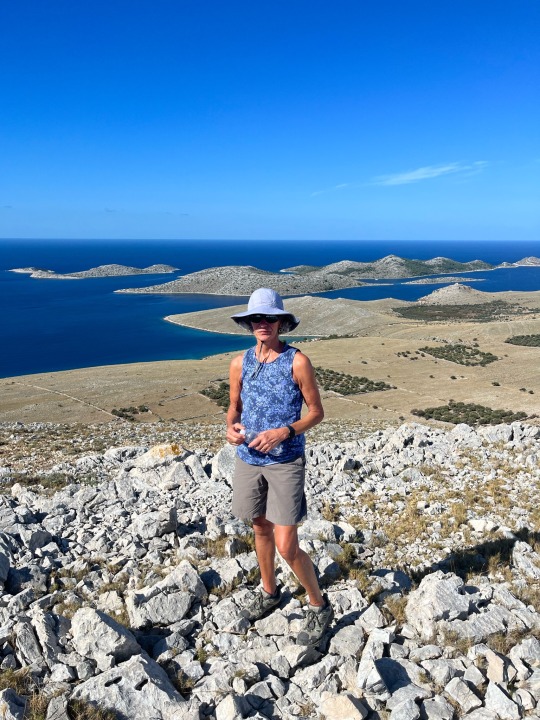
.

.

Hanging out after our climb and swim

Hanging in the garden after dinner

Moonrise while we waited for the ferry back to Zadar.
2 notes
·
View notes
Text
Konoba Suha Punta auf Kornat

Am nordwestlichen Ende der Insel Kornat liegt eine der urtümlichsten Konobas der Kornaten. Die Konoba Suha Punta ist einer der Lieblingsplätze des Verfassers dieser Zeilen, deshalb eine etwas ausführlichere Beschreibung.
Bis 2019 führten Mile und seine Frau Zora die Konoba. Die beiden stammten ursprünglich aus dem Dorf Zaglav auf Dugi Otok, arbeiteten und lebten jedoch viele Jahre in Österreich.
Mile war Bauschlosser, seine charismatische Erscheinung würde jedoch perfekt zu einem Schauspieler oder Künstler passen.
Unvergessen der Anblick, wenn Mile dann und wann mit uns einen Pelikovac trank, und dazu die Zitronen pur verzehrte. Sein ausdrucksvolles Antlitz wackelte wie ein englischer Pudding im Rhythmus seiner Kaubewegungen, was war das für ein Spaß!
Beide sprachen sehr gut deutsch, der österreichische Dialekt von Zora führte einen sofort an die Ringstraße, Schönbrunn und das Cafe Landtmann, eine Dame die für Jeden das richtige Wort parat hatte.
Hier in der Konoba führte sie das Regiment – und es war ein Gutes!
Und bedacht wie Zora und Mile sind, gaben sie die Konoba in gute Hände!
Ein junges Team aus Zagreb schaukelt seither den Laden - und das perfekt. Herausragend dabei der Pächter Davor, der "beste Grillmeister Dalmatiens" Riki, und Katharina, eine unglaublich charmante und freundliche Studentin aus Split, die sich hier im Sommer ihr Studium verdient.
Zu empfehlen ist hier gegrillter Branzin und dazu ein paar gerillte Ligne (Calamari). In all den Jahren die ich bisher die Konoba besuchte, war der Fisch immer auf den Punkt gegrillt: knusprig, nicht verbrannt, das Fleisch wunderbar zart, und unglaublich rauchig! Nirgends schmeckt Gegrilltes so gut wie hier - trotz vieler Biere hat mir Riki sein Geheimnis nie verraten, vielleicht wird's ja noch - ich werd's dieses Jahr wieder probieren ;-)
Tagsüber sind zahlreiche kleinere Ausflugsboote und Sportbootefahrer hier, am Abend jede Menge Stammgäste die sich das Team über die Jahre redlich verdient hat.
Und so kommt ihr ganz bequem zur Konoba - LINK
Für Reservierungen: Konoba Suha Punta: +385 95 398 6130
Zurück zum Blog
Am nordwestlichen Ende der Insel Kornat liegt eine der urtümlichsten Konobas der Kornaten. Die Konoba
Lesen Sie den ganzen Artikel
0 notes
Text
[Sažetak] Escaping the Build Trap - Melissa Perri
Nemojte zaglaviti u Build Trap. Build Trap je trenutak kada se tvrtka orijentira na output umjesto na outcome. Kada se tvrtka orijentira na, i hvali se sa, vanity metrikama umjesto metrikama relevantnim za krajnje korisnike produkta koji grade i prodaju.
Tvrtke često završe u Build Trap stadiju kada žele postići, i održati, velocity isporuka zanemarujući ono bitno - što želi i treba krajnji korisnik. Build Trap je najčešće faza nakon uvođenja novih tehnologija te principa i kulture (poput mikroservisne arhitekture, Agile, DevOps) te se zaboravi koji je stvarni razlog postojanja produkta i same tvrtke.
Nemojte se dovesti u Build Trap. Nemojte zaglaviti u Build Trap. Pročitajte knjigu, prepuna je savjeta kako izbjeći i osloboditi se ovog fenomena.

Preface
"This book is for every product person"
"This book is a guide to getting out of the build trap with great product management"
Part I - The Build Trap
"The build trap is when organizations become stuck measuring their success by outputs rather than outcomes. It's when they focus more on shipping and developing features rather than on the actual value those things produce"
"The build trap is a terrifying place for companies because it distracts them. Everyone is so focused on shipping more software that they lose sight of what is important: producing value for customers, hitting business goals, and innovating against competitors"
"The build trap isn't just about shipping software. It's about realizing you have to change the way you've always done things"
"To get out of the build trap, you need to look at the entire company, not just the development team"
"Companies end up in the build trap when they misunderstand vale. Instead of associating value with outcomes they want to create for their business and customers, they measure value by number of things they produce"
"To gain this understanding , companies need to get their employees closer to their customers and users so that they can learn from them"
"To be strategic and to have people operate strategically, we need to stop judging teams based on the quantity of features shipped"
"Product-led companies understand that the success of their product is the primary driver of growth and value for their company"
"Sales-led companies let their contracts define their product strategy"
"Visionary-led companies can be very powerful - when you have the right visionary. But, there aren't many Steve Jobses floating around"
"Another common way of operating is the technology-led company. The problem is that they often suffer from a lack of market-facing, value-led strategy"
Part II - The Role of the Product Manager
"Product management is the domain of recognizing and investigating the the known unknowns and of reducing the universe around unknown unknowns"
"Product managers identify features and products that will solve customer problems while achieving business goals"
"Agile does indeed promote a better way of collaboration and a faster method for building software, but it largely ignores how to do effective product management"
"Listening to everyone's opinion is important, but it doesn't mean a product manager should implement every suggestion"
"Product managers are not project managers, although a little project management is needed to execute on the role correctly. Project managers are responsible for the when. Product managers are responsible for the why"
"One of the worst traits a product manager can have is the lone-wolf mentality - the idea that they are the only one responsible for the success of their product"
"It's about understanding the entire picture of the organization and figuring out how the product - not just experience - fits into it"
"A product manager must be tech literate, not tech fluent"
"A good product manager is thought how to prioritize work against clear, outcome-oriented goals, to define and discover real customer and business value, and to determine what processes are needed to reduce the uncertainty about the product's success in the market"
"Tactical work for a product manager focuses on the shorter-term actions of building features and getting them out the door"
"Strategic work is about positioning the product and the company to win in the market and achieve goals"
"Operational work is about tying the strategy back to the tactical work. Here is where product managers create a roadmap that connects state of the product to the future state and aligns teams around the work"
"Instead of working toward a goal and saying no to anything that doesn't get us there, we tend to look ways to develop more things related to our little slice of the product"
"While organizations lack a coherent product strategy that is ruthlessly prioritized around a few key goals, they end up spreading themselves thin"
Part III - Strategy
"A good strategy is not a plan, it's a framework that helps you make decisions"
"Netflix can change tactics or kill ideas because it commits itself not to the solutions they are building but rather to the outcomes these solutions produce"
"Thinking of strategy as a plan is what gets us into the build trap"
"In his book on the subject, The Art of Action, he writes: Strategy is a deployable decision-making framework, enabling action to achieve desired outcomes, constrained by current capabilities, coherently aligned to existing context"
"A good strategy should sustain an organization for years. If you are changing strategy yearly or monthly, without good reason from data or the market, you are treating your strategy as a plan rather than as a framework"
"This failure stems from the actions taken to fill the following gaps that exist between outcomes, plans, and actions"
"The knowledge gap is the difference between what management would like to know and what the company actually knows"
"The alignment gap is the difference between what people do and what management wants them to do, which is to achieve the business goals"
"The effects gap os the difference between what we expect our actions to achieve and what actually happens"
"If you're aligned coherently and you have a good strategic framework, you can then allow the people to make decisions without a lot of management oversight"
"A good company strategy should be made up of two parts: the operative framework, or how to keep the day-to-day activities of the company moving; and the strategic framework, or how the company realizes the vision through product and service development in the market"
"Strategy deployment is about setting the right level of goals and objectives throughout the organization to narrow the playing filed so that teams can act"
"Strategy creation is the process of figuring out which direction the company should act upon and of developing the framework in which people make decisions"
"Strategic intents communicate the company's current areas of focus that help realize the vision"
"Strategic intents should be at a high level and business focused"
"Product initiatives translate the business goals into the problems that we will solve with our product"
"Product manages are in charge of making sure the product initiatives and options are aligned with the vision of an existing product or portfolio"
Part IV - Product Management Process
"Product metrics tell you how healthy your product is, and ultimately, your business, given that a healthy product contributes to overall health of the business"
"Frequently, teams turn to measuring what we call vanity metrics. This concept, introduced in Lean Startup, is about goals that look shiny and impressive because they always get bigger. People are excited to share how many users are on their product, how many daily page views they have, or how many logins their systema has. Although there number my make you look great to investors, they do not help the product teams or business make decisions"
"There are many product frameworks available to help you think through the appropriate product goals. My two favorite are Pirate Metrics and HEART metrics"
"Whatever your metrics, it's important to have a system of metrics, not just one, to guide product decisions"
"Problem-based user research is generative research, meaning that is's purpose is to find problem you want to solve"
"When conducting problem-based research, you are trying to identify the pain point and the root cause of the problem"
"Explain to them why you are testing, when and how the experiment will end, and what you plan to do next. Communication is the key to a successful experimentation process"
"Learning reduces risk. The goal of solution exploration is to get faster feedback"
"A North Star document explains the product in a way that can be visualised by the entire team and company. This includes the problem it is solving, the proposed solution, the solution factors that matter for success, and the outcomes the product will result in"
"The team was oriented around outcomes, and then the leadership team gave it the space to figure out how to achieve those outcomes. These are the marks of a product-led company"
Part V - The Product-Led Organization
"The product-led organization is characterized by a culture that understands and organizes around outcomes over outputs, including a company cadence that evolves around evaluating it's strategy in accordance to meeting outcomes"
"If there is one main reason I have seen companies fail to make a transition, it's the lack of leadership buy-in to move to an outcome-oriented company"
"Visibility in organizations is absolutely the key"
"During quarterly business review meetings, the senior leadership team, made up of the executives and the highest level of the organization, should be discussing the progress toward the strategic intents and outcomes of a financial nature"
"The product initiative review is another quarterly meeting that can be staggered with the quarterly business review on off months. Here we review the progress of the options against the product initiatives and adjust our strategy accordingly"
"Release reviews provide the opportunity for teams to show off the hard work they have done and to talk about success metrics. These should happen monthly, before features go out, to showcase what is in the pipeline to be released"
"I want to be clear here: it is not a success if you fail and do not learn"
"When you don't have safety built in to your company, your product managers won't feel comfortable trying something new. No one will"
Dodatne Poveznice
Good Reads: Escaping the Build Trap
Amazon: Escaping the Build Trap
Blackwell's: Escaping the Build Trap
Preuzimanje sažetka
https://vladimir.remenar.net/sazetak-escaping-the-build-trap-melissa-perri/
Read the full article
0 notes
Text
10 loših vozačkih navika koje štete vašem automobilu

Loše vozačke navike mogu se lako steći. Možda niste ni svjesni da puno toga što obično radite dok vozite automobil može uzrokovati naprezanje sklopova vozila pa čak i trajnu štetu na vašem automobilu koja će vas skupo koštati. Budući da je automobil jedno od najvrjednijih sredstava na koje se oslanjate u svakodnevnom životu, morate znati da način na koji ga vozite može itekako utjecati na njegovu trajnost i sigurnost.
Kako biste izbjegli dosadne kvarove i zaštitili se od skupih računa za popravak, navesti ćemo deset uobičajenih vozačkih navika koje trebate izbjegavati. Vaš automobil i bankovni saldo će vam biti zahvalni na tome.
1. Udarne rupe i ležeći policajci
Većina od nas prelazi preko rupa ili ležećih policajaca većom brzinom nego što bi trebalo. Međutim, udarac u rupu ili skok preko ležećeg policajca imaju veći učinak od samo neudobne vožnje.
Udar od udarca u rupu može oštetiti upravljač, ovjes i poravnanje kotača vašeg automobila, a prebrza vožnja preko ležećeg policajca može oštetiti prednji, stražnji ili donji dio automobila, uključujući ispušni sustav.
Najbolje je biti oprezan, izbjegavati udarne rupe ili ih nježno prelaziti te usporiti prije ležećih policajaca. Vaš će automobil duže ostati u boljoj formi, a vi ćete pomoći u zaštiti ostalih sudionika u prometu i pješaka.
2. Vožnja na praznom spremniku
Kontrolno svjetlo se upravo uključilo (opet) i ponestaje vam goriva. Osim uzbuđenja koje donosi kockanje koliko bi još mogli izdržati, vožnja na praznom spremniku ili blizu oznake ‘E’ nije tako dobra za vaš automobil.
Redovita vožnja na praznom spremniku neprestano opterećuje pumpu za gorivo, koja bi mogla početi usisavati zrak, što bi moglo dovesti do pregrijavanja i kvara.
Osim toga, vožnja na preniskoj razini goriva u spremniku mogla bi dovesti do toga da se krhotine i nečistoće zaglave u pumpi za gorivo. Sve sitne čestice koje se probiju u spremnik za gorivo obično se slegnu na dnu i ostanu tamo dok vaš automobil ne pokuša pokupiti svaku posljednju kap goriva sa dna spremnika. To povećava rizik od začepljenja pumpe za gorivo ili filtra za gorivo krhotinama.
Zato spremnik goriva uvijek držite najmanje 1/4 punim kako biste izbjegli buduće skupe popravke, ali i smanjili bojazan da ćete ostati bez goriva na cesti.
3. Ubacivanje u ‘rikverc’ prije zaustavljanja
Bez obzira u kolikoj ste žurbi, ubacivanje u brzinu prije nego što se automobil zaustavi nikada nije dobra opcija. Mjenjač i prijenos su napravljeni za promjenu stupnjeva prijenosa, a ne za zaustavljanje automobila.
Prebacivanje u ‘rikverc’ prije zaustavljanja uzrokovat će ozbiljna i vrlo skupa oštećenja mjenjača. Upamtite, bez obzira vozite li automatik ili automobil sa ručnim mjenjačem, obavezno koristite kočnice za potpuno zaustavljanje prije promjene brzina.
4. Vožnja na kočnici
Možda ćete otkriti da kada vozite nizbrdo ili u prometu stani-kreni, držite nogu na papučici kočnice dulje vrijeme. To može dovesti do pregrijavanja kočionih pločica i gubitka dijela snage potrebne za zaustavljanje, što vam otežava brzo i sigurno zaustavljanje. Kako biste izbjegli vožnju na kočnicama, ranije smanjite gas, omogućite dodatni prostor između sebe i automobila ispred i prebacite u niži stupanj prijenosa kako biste koristili kočenje motorom. Kada trebate kočiti, lagano pritisnite papučicu, a zatim je pustite da se kočnice ohlade.
Kada redovito kočite naglo ili prekasno, kočione pločice i diskovi se brže troše. Kako biste izbjegli skraćivanje životnog vijeka kočionog sustava, uvijek kočite postupno dok se približavate i klizite do glatkog i blagog zaustavljanja.
5. ‘Turiranje’ hladnog motora
Nakon parkiranja automobila preko noći, motor je hladan i ulje se prirodno taloži na najnižoj točki, zahvaljujući gravitaciji. Prilikom pokretanja motora izbjegavajte ‘turiranje’ motora kako biste ga zagrijali. Jednostavno okrenite ključ i pustite ga da radi u praznom hodu, a zatim vozite laganim gasom, dopuštajući ulju da cirkulira i podmazuje dijelove motora.
Bez dovoljno vremena za zagrijavanje i pravilno cirkuliranje ulja, komponente motora nisu zaštićene kako bi trebale biti, a trenje uzrokovano naglim povećanjem okretaja može istrošiti dijelove brže nego što bi trebalo. Zamjena ovih dijelova može biti vrlo skupa.
6. Jahanje na ‘kuplungu’
Ako posjedujete automobil sa ručnim mjenjačem, možda će vam biti zgodno držati pritisnutu papučicu spojke, osobito kada se lagano krećete naprijed u sporom prometu. Jahanje spojke nikada nije dobra ideja jer napreže lamelu spojke i skraćuje njezin radni vijek. Štoviše, jamstvo ne pokriva komponente spojke jer se radi o habanju, odnosno potrošnom materijalu.
Koristite oslonac za nogu pored spojke kako biste bili sigurni da stopalo nije na papuči spojke. Također, kada krećete na uzbrdici, držite povučenu ručnu kočnicu, a mjenjač u neutralnom položaju dok ne budete spremni za kretanje, osim ako vaš automobil nema ugrađenu kontrolu držanja na uzbrdici koja će automatski aktivirati i deaktivirati ručnu kočnicu.
7. Preopterećenje prevelikom težinom
Mnogi od nas preopterećuju automobil kada odlaze na obiteljski odmor, prilikom selidbe i slično. Preopterećenje automobila opterećuje gume, kočnice i ovjes – da ne spominjemo povećanje potrošnje goriva i emisija. Osim toga, šteta od preopterećenja često nije dio jamstva za vozilo, a ako doživite nesreću, vaša polica osiguranja možda neće pokriti tako nastalu štetu.
8. Ignoriranje kontrolnih svjetala
Možda niste svjesni što znače ili ih jednostavno želite previdjeti, ali svjetla upozorenja na kontrolnoj ploči vašeg automobila način su na koji vam automobil priopćava probleme.
Kad god vidite malu crvenu lampicu upozorenja na ploči, najbolje je da pogledate priručnik za automobil. Pomoći će vam da saznate trebate li otići kod mehaničara ili nešto možete sami popraviti.
Neka od bitnih svjetala upozorenja na koja treba paziti su:
akumulator
motor/ECU
kočni sustav
servo upravljač
zračni jastuci
tlak ulja
rashladni sustavi
9. Zanemarivanje redovnog servisa
Uz užurbani životni ritam primamljivo je preskočiti servisni raspored koji je odredio proizvođač vašeg automobila. Izbjegavanje ili odgađanje servisa može dovesti do neočekivanih kvarova i skupih oštećenja. Rutinske provjere pomoći će vam da zamijenite sve istrošene komponente i omogućite rano otkrivanje problema prije nego što uzrokuju velike popravke u budućnosti.
Pridržavajte se rasporeda redovitog servisa kako biste održali zdravlje automobila i osigurali da je sve u najboljem redu za duži vijek trajanja.
10. Ne perete automobil redovito
Iako to tehnički nije navika vožnje, imati prljav automobil nije dobro za vanjski izgled automobila i vašu opću sigurnost. Ako se ne opere, prljavština, ptičji izmet i mrlje od smole s drveća mogu s vremenom izgristi prozirni premaz vašeg automobila, što može ugroziti zaštitu karoserije vozila.
Kako biste izbjegli probleme poput hrđanja, rupa i izbljeđivanja, pokažite svom automobilu malo ljubavi i redovito ga perite i mažite voskom. Možda ćete to trebati raditi češće ako se vozite po posebno blatnim ili prašnjavim mjestima. Ako živite ili ste na odmoru u blizini mora, slani zrak je posebno korozivan, zbog čega je iznimno važno redovito prati vanjski dio automobila, kao i podvozje.
Zvuči li vam išta od ovoga poznato? Ne trebate paničariti. Prvi korak u ispravljanju loših vozačkih navika je njihovo prepoznavanje. Nakon što se suočite s njima i počnete ih otklanjati, smanjit ćete rizik od dosadnih popravaka koji se mogu izbjeći, a vaše vozilo će se, isto kao i vi osjećati i izgledati puno bolje.
A ako se želite posavjetovati o dobrim navikama vožnje i o redovitom održavanju vašeg Suzuki automobila, posjetite ovlašteni Suzuki servis u našem novom autosalonu Suzuki Antares Centar u Zagrebu ili nas kontaktirajte na telefon 01 5540 090.
0 notes
Text
SAVET DANA - NEDELJA 23.10.22
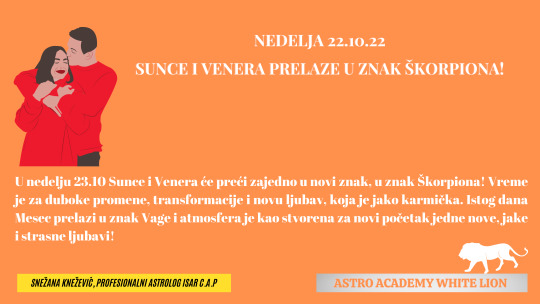

Danas Venera i Sunce zajedno prelaze u znak Škorpiona!
Vreme je za duboke promene, transformacije i novu ljubav, koja je jako karmička.
- Takođe i Mesec je danas prešao u znak Vage i atmosfera je kao stvorena za novi početak jedne nove, jake i strasne ljubavi!
- Čak će se i Saturn aktivirati i posle punih četiri meseca krenuće direktno u znaku Vodolije.
- Mi znamo koliko je Saturn zainteresovan za naše ljubane priče i partnerske odnose, jer je egzaltiran u znaku Vage. Na ovaj način i on nam poručuje da je vreme da krenemo napred.
U šta krećemo je drugo pitanje, ali svakako ulazimo u neko novo vreme, koje će biti jako interesanto i dinamično.
Ljubav koju nađete u narednim danima je ljubav sa osobom koju poznajete iz prethodnih inkarnacija.
Samo dva dana nakon prelaska Sunca i Venere u znak Škorpiona, imaćemo Solarnu eklipsu 25.10. na 2 stepenu Škorpiona.
Aktiraće se Muški vodeni zmaj, kojim vlada Venera. Ljubav na prvi pogled je ono što bi moglo da vam se dogodi!
Međutim, pre toga moramo da prođemo kroz veliko čišćenje i osvešćivanje, jer eklipsa uvek predstavlja lift koji ide u oba pravca.
Ili ćemo krenuti, ka svetlosti, ka gore, ili ćemo se zaglaviti u nekim podrumskim prostorijama, gde nas čeka strah i senka.
Zato se vidimo 25.10.22 u 19h i pričamo o ljubavi, istini i promeni!
Svi polaznici radionice će dobiti naknadno posle predavanja snimak radionice i pisani materijal vezan za predavanje
- Uplatu je moguće izvršiti do utorka 25.10.2022 do 15h
Cena radionice je 30 eur ili 3.500,00 dinara
SVI KOJI SU RANIJE PLATILI CIKLUS OD 3 RADIONICE ILI CIKLUS OD 12 RADIONICA, NE TREBA NIŠTA DA PLAĆAJU!
Ako želite da se prijavite, pišite mi na:
+381 69 299 0253
Snezana Knezevic
Profesionalni astrolog ISAR C.A.P
učitelj u školi Astro Academy White Lion i life coach
0 notes
Text
Welcome to Dugi otok

It's been my wish for quiet some time to visit Dugi otok (Long Island), the long and the most distant of the Croatian islands located in the center of Croatian part of the Adriatic sea. Actually, I visited one part of it – the Nature Park Telašćica, when I was a kid more than 15 years ago…but never other places and with the new purpose. However, my wish had been granted surpassing all the expectation I had about this trip.
The main reason why I wanted to travel there was to find and record the locals who speak the local idioms. For those of you who've been following me for the last couple of years and especially my YouTube channel you know that this was a super exciting trip for me. These native speakers represent a national and cultural treasure in terms of lingusitic heritage and a history of the litoral and maritime people living here for centuries, with some of them being isolated or with little touch to the land (terraferma). Thus the excitement to hear the living past and a nice blend of the Croatian Slavic culture and the Mediterranean Latin influence.
Apart from finding the native speakers I was excited to find out more about being and living as an islander. So I had to chance to record, hear and take photos of stories and experiences of the local people from several villages including both youth and seniors.
How it all started
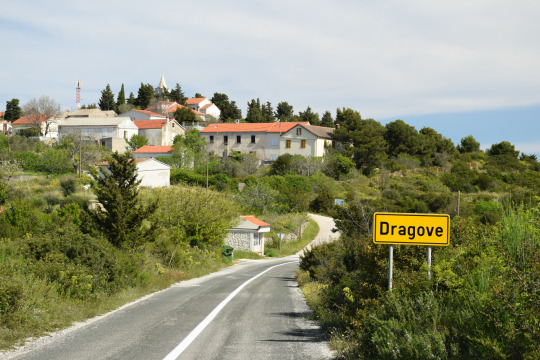
I was super lucky to be given the opportunity to stay for four days on the island and meet many people whose help I never expected. I got the accommodation for free at the local monastery of St Michael in Zaglav which was thrilling enough and especially valuable since they allowed me to stay during the festive days around Easter. As soon as I got the confirmation that it's not a hallutination but a reality I looked for help among friends and acquaintaes who could aide me in getting to know the island and the locals. Without them this trip would have looked totally different as I knew practically nobody there. In the end I made lots of friends and had plenty of fun while doing my mission. I spent literally days and hourse right before the trip to get the additional camera equipment, gather as much as valuable information about the locals as possible, creating my own map of the potential people for the intervju and preparing the daily routes.
But before we dive into the adventures here's a some info about the island.
About Dugi otok
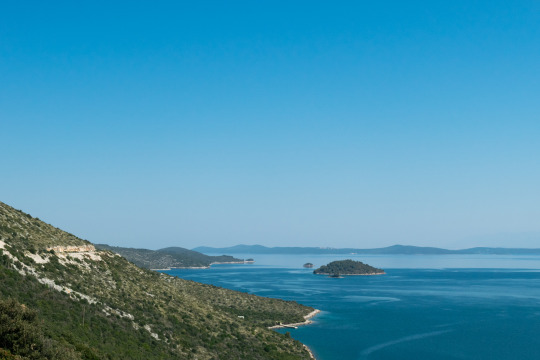
What do you need to know about this paradise? Dugi otok is the largest of the North-Dalmatian islands situated in the central part of the Croatian Adriatic. Iti s also the last island before the open sea and Italy on the other side of the Adriatic bay. Just like the majoritiy of our islands it has many hills and small bays with its highest peak of Vela Straža at 338m. The island is around 45 km long (hence the name) but at some points its width ranges between 1 and 4 km. This contrast was especially visible when I was driving a car from the south and at one point I stopped and looked to my right – there you see the islands towards Zadar and Velebit mountain. Then you turn to the left and see the nothing except for the blue sky, horizon and the deep blue Adriatic sea. However, during the crystal day and with a good eye sight one can see the eastern Italian coast, more precisely – the Apenine mountains. After all, Italy is less than 200 km away across the sea.
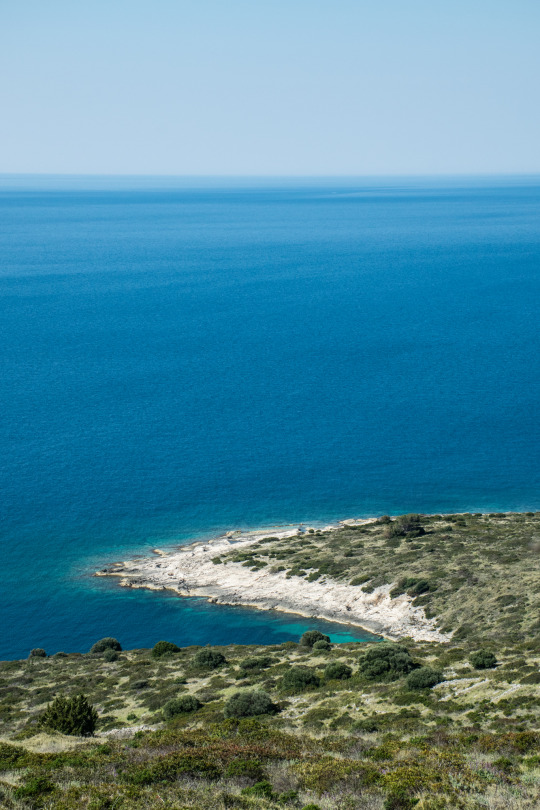
Its western coastline bordering the open sea characterize the sharp contrasts: the southern part around the Nature Park Telašćica is surrounded with impressive cliffs that go up to 80m in height. Telašćica is one of the most beautiful place sin Zadar county and frequently visited by numerous tourists each year.

On contrary, on the other side of the island you can find more peaceful bays. The two most notable beaches are Sakarun and Veli Žal where Sakarun is the most famous one. However, last years due to growing number of visitors and greediness it no longer looks and is as it was 10 years ago. I also never went there but visited Veli Žal instead. All in all, the nature on this island is incredible and as the locals say – you hardly notice any seasonal change. It always looks as if the time had stopped between spring and early autumn. Always green and no leafs falling. In terms of nature this island will be a perfect place to escape the reality and the stress of the modern lifestyle spent in larger urban areas. Clean sea, peaceful nature and the welcoming locals.
People, customs and history
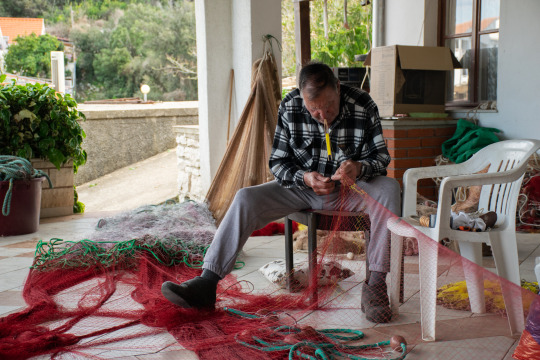
Speaking of locals the island has a population of roughly 1500 inhabitants spread in around 12 local villages. The largest of them is Sali in the southeastern part of Dugi otok with the population of around 800. On contrary, places such as Dragove or Veli Rat in the north have between 40-70 inhabitants statistically. However, accoridng to the stories, there's far less people who actually live for the whole year. The sad truth and reality is that these places will become ghost towns within 10-20 years as the majority of these locals are seniors over 80 years old. The thing is – apart from them most of the visitors are so called „weekenders“ – the islanders who live on the land (e.g. in Zadar) who come there over the weekend…or the other part that's present during the summer are the diaspora. These are the people whose parents, grandparents or further ancestors emmigrated to the United States, Southern America or Australia and New Zealand at the beginning of the 20th century or around the years of the WW2 in search for better opportunities and life across the sea. There are even some remains left of the WW2 bunkers and ship tunnels that I am going to describe you later (I couldn't resists visiting some of them). And even today one can find near the central part of the island a restricted zone which belongs to the military whose base is on top of the hill. It's said it used to watch over the potential threat that comes from the south or across the Adriatic sea.

The population of the island was thus much larger, actually surprisingly larger. However, the Great War in 1918 and the Second World War had taken the toll with great consequences. Many of the islanders died or were killed during those time, especially the young people, men, who were meant to start new families. Those who survived either stayed or moved to new places. Some places used to have a lot of children attending the schools. Now some say it's „a success“ when they managed to gather up to 10 children of the elementary school in total. And they come from different villages.
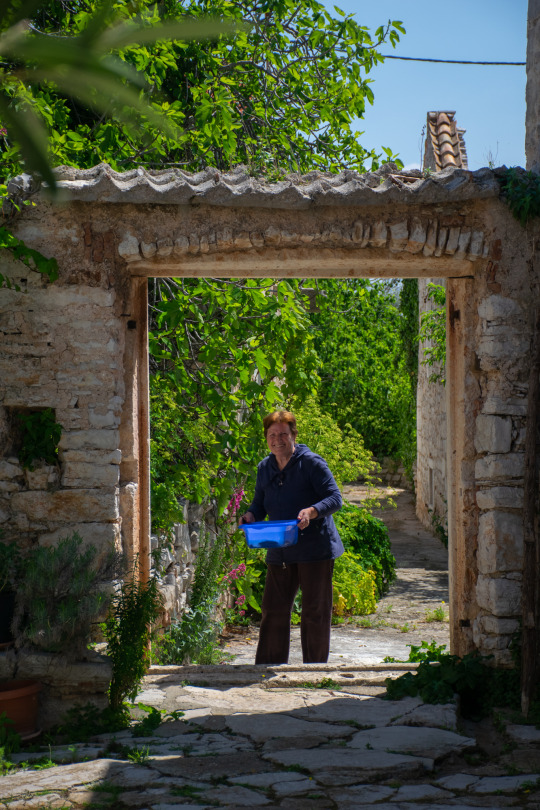
Being on the island many of the locals have traditionally been turned towards the sea and what it offers. It's not unusal to find people who have spent their lives sailing around the world. Some have been fishermen. Some are into agricultulre and what it offers. Unlike us who live on the mainland here you can't have super large fields but smaller ones where you take care of goods and cultures such as figs, oranges, lemomns, tomatoes, potatoes, salad and olives. In Sali there is a fish factory which provides employment for good amount of the locals. There is another important factor in the lives of the islanders and that is the Church and religion. It's not unusual to find many of them to be (kinda) devoted Catholics who go to the church every Sunday. After all, as some explained me, it's also a social thing or event, when you think about it. And living there for centuries, relatively isolated and surrounded by nature and vast sea surface, one shouldn't be surprised to see faith and religion rooted deeply in the locals. And being an islander does not mean living an easy life, as you are going to find out. Speaking of religion there is this Franciscan monastery of St Michael in Zaglav with a church that was built in mid-15th century. That's the place I stayed at.

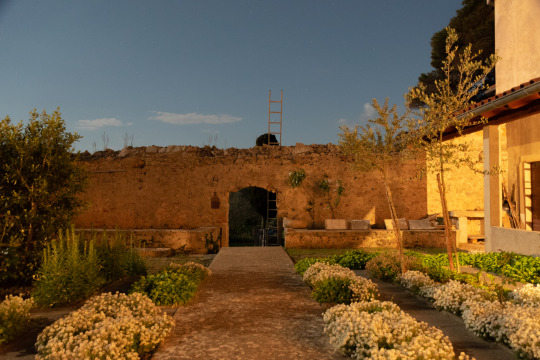
The places on the island are connected with one main road from which you have amazing views over the surrounding islands and area. The island has also got quiet good connection with the mainland via trajects and speedboats (catamaran). There are four catamaran lines that go daily from Zadar to Dugi otok. If you are planning a trip on Dugi otok by car you will arrive by traject to Brbinj in the northern part of the island. The same goes if you want to leave the island by car. Speaking of cars the only gas station on the whole island is located in Zaglav in the south. That's also the place I arrived to and stayed at for four days.
What else to add? During the summer season many are some festivals related to religious events, local music and traditional kitchen. Those who prefer to spend their time actively they can go exploring the area, follow many hiking roads, visit the caves, Park Telašćica or National Park Kornati. If you are more into sports then I suggest finding some diving locations or courses, try running, trekking, biking, trail, sailing etc. At the northernmost point of the island at Veli Rat there is another landmark of Dugi otok - the lighthouse of Veli Rat.
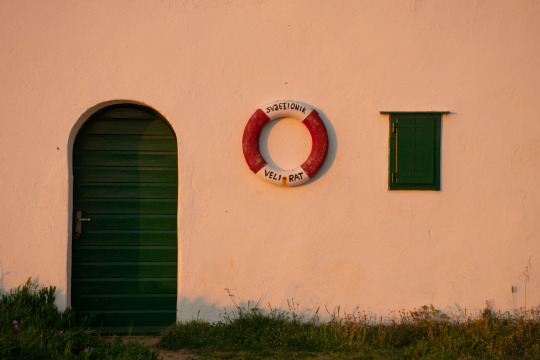

I forgot to mention some of the older history of the island. Here are a few interesting things to know. The island was already inhabited with settlers in the early ages in paleolithic and mesolythic. Several years ago scients discovered the human skelleton that date back to 11 000 years BC. This discovered male Dalmatian known as „Šime“ died unnatural death at the peak of his retirement age of 40.
One can find the remains of the settlements and stuff of the ancient Illryians. There are also several caves on the island and around Telašćica park one can find tomb hills dating back to Iron age 800-400 BC. The last thing I'd add here is the Grpašćak Fortress on the western coast above the cliffs of Telašćica. It was built in 1911 by the Austro Hungarian Monarchy which served as a military patrol base. I came close by my first evening on the island but more about it in the next post..
Time for a break

Alright! I hope you have some idea about Dugi otok. More in details on specific topis as we surf through the days.
Grgo
#dugi otok#dugiotok#croatia#dalmatia#travelling#long island croatia#adriatic sea#local people croatia#locals on islands#potepuh#zaglav#sali#božava#veli rat#lighthouse#nature#landscape#dragove#savar#telašćica#telascica#cliffs#adriaticsea
4 notes
·
View notes
Text
I tako...
I tako... ima tih nekih oluja...
koje samo prodju... kroz nas...
naprave malo nereda... i nestanu...
Ima i onih malo većih... jačih...
onih koje se uvuku... tu negde...
duboko u nas... nekako se zaglave...
i zauvek ostanu... tu u nama...
Znaš ima tih nekih... tišina...
koje nam prijaju... koje odmaraju...
Koje nam kažu... ono sto naglas...
nikada niko neće... reći...
Ali ima i onih... u koje se nekako...
uvuče taj šapat... nemira...
pa u njima... zauvek odzvanja...
I tako... ima u nama...
tih nekih priča... nikada ne ispričanih...
tih nekih uzdaha... u duši zarobljenih...
i ima po koja suza... u oku ostala...
i nikada... nikada ne isplakana...
Ima tih nekih stvari... sitnica...
koje tako jako... želimo...
I ima tih nekih stvari... sitnica...
koje nikada... imati nećemo...
-Nošen dahom sna
#ljubav#zivot#citati o zivotu#najljepsi citati#love quotes#ljubavni tekstovi#ljubavni citati#ljudi#emocije#emotions#lovers#quotes#citati#quotation#love text#couple#nosendahomsna#poezija
4 notes
·
View notes
Photo







Istanbul: Priča o dve zemlje
Turci često opisuju Istanbul kao sredovečnu lepu, ali tužnu damu, budući da je ovaj prelepi grad bio svedok mnogih istorijskih prekretnica, puno careva, osvajača i dramatičnih događaja.
Grad je tako lep, da ima pesama i pesama o ovom prelepom neredu koji nazivamo Istanbulom ili njegovim starim imenima; Vizantion, Carigrad, Stambol i mnogi drugi. Istanbul je uglavnom poznat po svom strateškom položaju, mostovima koji povezuju Aziju i Evropu, džamijama, tulipanima, galebovima i turskim bagelima / čajnim duetom. To je jedan veliki grad sa ogromnim gužvama na ulicama. Sa populacijom preko 20 miliona i fascinantnim brojem turista, jedan je od najvećih kulturnih centara na celom svetu. Stari deo grada je uglavnom na evropskoj, a moderni deo na azijskoj strani. Ali to je nekako kao jin-jang, naravno, možete pronaći savremene delove na evropskoj strani, a istoriju na azijskoj. I dve informacije koje će vas možda iznenaditi: Istanbul nije glavni grad Republike Turske. To je Ankara. U Istanbulu se smenjuju sva 4 godišnja doba, uključujući naravno i zimu, često sa puno snega i hladnoće koja je čak zaledila Mramorno more 1954. godine, a isto to se dešavalo više puta kroz istoriju. I ne, ne govori se arapskim jezikom i kamile nisu glavno prevozno sredstvo ;-) .
Do grada možete doći sa 2 različita aerodroma sa obe strane grada. Na evropskoj strani postoji aerodrom Ataturk, a na azijskoj aerodrom Sabiha Gokcen. Ne postoji glavna železnička stanica, pa ne možete vozom da uđete u grad, ali javni prevoz je rasprostranjen, prilično avanturističan, jer je malo komplikovan i vrlo prepun. Ali ako ste mazohista, takođe možete iznajmiti automobil i satima zaglaviti u čuvenoj gužvi u Istanbulu. Najbolji način da pređete s jedne na drugu stranu je korišćenje čamaca i trajekata, jer možete videti istorijske znamenitosti, prelepi Bosfor i hraniti galebove koji će slediti vaš čamac! Ali naravno, možete koristiti i autobuse, tramvaje, metro linije i taksije.
Šta obavezno videti i koja mesta obići?
Ok, uzmite šolju čaja ili kafe jer će spisak biti podugačak.
Istanbul je poznat po svojoj velikoj istoriji koja datira iz 660. godine pre Hrista, Rimskog carstva, Vizantijskog i Osmanskog carstva. Ako želite da pogledate istorijske spomenike iz tog doba, trebalo bi da počnete da otkrivate Istanbul sa trga Sultanahmet, gde možete pronaći Aja Sofiju, palatu Topkapi, džamiju Sultanahmet i cisternu bazilike.
Palata Topkapi se koristila u 15. Veku kao rezidencija osmanlijskih sultana. Danas je ova ljupka palata sjajan muzej u kojem možete videti stotine soba i odaja, osmanski harem i riznicu, dijamant Spoonmakera - koji je jedan od najvećih dijamanata - odeću, oružje, oklope i pisma, a svi eksponati nalaze se na Uneskovoj listi zaštićenog kulturno-istorijskog nasleđa.
Džamija Sultan Ahmed ili Sultan Ahmet džamija je istorijska ali i verska znamenitost koja se i dalje koristi za muslimanske molitve. Ova Plava džamija izgrađena je između 1609. i 1616. godine i sadrži grobnicu sultana Ahmeta, medresu, hospicij i crvene tepihe za molitve. Unutar džamije ćete sigurno biti očarani turskim ručno rađenim, obojenim plavim pločicama.
Kula Galata je srednjovekovna kula koja je sagrađena 1348. godine tokom proširenja genovske kolonije u Carigradu. Ova kula stoji u Galati / Karakoi u Istanbulu i visoka je 66,90 metara. Sa vrha se prostire prelep panoramski pogled. Prema osmanskom istoričaru i putniku Evliji Čelebi, Hezarfen Evlija Čelebi leteo je od tornja Galata do Uskudara koristeći veštačka krila!
Palata Dolmabahče nalazi se na evropskoj obali Istanbula i bila je glavno administrativno središte Osmanskog carstva. Ova barokna, rokoko i neoklasično dizajnirana palata je najveća u Istanbulu, a u njoj možete pronaći ručno oslikane pločice, mermer iz Mramornog mora, najveći boemski kristalni luster na svetu, sjajnu kolekciju uljanih slika, egipatski alabaster i još mnogo, mnogo, fascinantnih stvari. Unutrašnjost je u velikoj meri ukrašena zlatom i kristalima, imala je plinsko osvetljenje i toalete, dok ih čak ni u evropskim palatama u to vreme nije bilo.
Aja Sofija, znači „Sveta mudrost“, bila je grčka pravoslavna crkva koja je pretvorena u carsku džamiju. Ova ružičasta džamija i muzej izgrađeni su 537. godine i unutar džamije možete pronaći mihrab i minbar a sa spoljašnje strane četiri minareta.
Džamija Sulejmanija je druga po veličini u gradu i nezaobilazna znamenitost grada. Izgradio ju je između 1550.-1557. godine genije turske arhitekture Mimar Sinan. Nova džamija je izgrađena između 1660. i 1665. godine, koja se nalazi u mestu Eminonu.
Cisterna Bazilika je najveća od nekoliko stotina drevnih cisterni ispod Istanbula. Izgrađena je između 3. i 4. veka tokom ranog rimskog doba. Drevni tekstovi navode da je ova bazilika imala vrtove. Unutar ove utonule bazilike možete pronaći dva stuba koja su ponovo upotrebljena i isklesana u vidu Meduze i kokošjeg oka.
Aja Irena je još jedna grčka istočno-pravoslavna crkva koja se nalazi u spoljnom dvorištu palate Topkapi. Danas se koristi kao muzej i koncertna sala. Rustem Pasha džamija je otomanska džamija iz 16. veka u kojoj možete pronaći puno neverovatnih pločica!
Devojačka kula je kula koja leži na malom ostrvcu u Mramornom moru. Visok je 220 metara, a sagradio je 1110. godine vizantijski car Aleksije Komnin. Legenda kaže da je car sagradio ovu kulu za svoju voljenu ćerku, jer se carstvom od usta do usta pronosilo proročanstvo da će je zmija otrovnica ubiti na njen 18. rođendan. Zato je zatvorio svoju ćerku u ovu kulu i često je posećivao. Na njen 18. rođendan, car joj je doneo korpu sa egzotičnim voćem, ali nije shvatio da se unutar ovog egzotičnog voća krije zmija, pa je zmija ugrizla princezu u naručju njenog oca, i tako se proročanstvo obistinilo.
Rumeli Hisarı je srednjovekovna tvrđava i sagrađena je između 1451. i 1452. godine kako bi se pripremila za osmansko osvajanje Konstantinopolja.
Džamija Ortakoi sagrađena je 1721. godine i jedna od najpopularnijih turističkih atrakcija grada, a kako se nalazi na obali mora ima neverovatan pogled na Bosfor!
Bosforski most je jedan od tri mosta između Azije i Evrope. Dug je 1560 metara, a visok 165 metara.
Muzeji u Istanbulu
Muzeji arheologije u Istanbulu sastoje se od tri glavna muzeja; Arheološki muzej, Muzej drevnog orijenta i Muzej islamske umetnosti. Osmanski sultan Abdulaziz bio je toliko impresioniran arheološkim
muzejima u Parizu i Beču, da je želeo da se sličan arheološki muzej osnuje u Istanbulu. Ovaj muzej možete posetiti od 09 do 19 h, osim ponedeljkom.
Istanbul Modern je muzej savremene umetnosti u Bešiktašu. U ovom muzeju možete pronaći stalnu kolekciju turskih slikara s kraja 19. do 21. veka kao i različite tematske izložbe koje se periodično organizuju. Unutar muzeja nalaze se i prodavnice, restorani, bioskop i biblioteka umetnosti.
Muzej Rahmi M. Koc je privatni industrijski muzej istorije transporta, industrije i veza. Unutar muzeja možete pronaći stare trkačke automobile, sportske automobile, salon / kupe i kabriolet, stari istanbulski tramvaj, sultanovu kočiju, parnu lokomotivu uskog koloseka, teretni brod, motorni čamac, kolekciju vazduhoplovnih delova, avionske motore, avion, model telegrafskog patenta Thomas Edisona, sat sa Strasbourgške kupole i mnogi toga drugog!
Turski i islamski muzej umetnosti izgrađeni su 1524. godine, a u njemu možete pronaći kolekcije islamske kaligrafije, pločice i prostirke i još mnogo etnografskih postavki.
Miniaturk je najbolje mesto za odlazak sa decom, jer je jako zabavan i jedan od najvećih minijaturnih parkova na svetu i sadrži tursko istorijsko nasleđe.
Muzej Pera je muzej uglavnom fokusiran na orijentalizam u 19. veku, a sagrađen je 1893. Takođe je domaćin brojnih izložbi i sadrži svetski poznate pločice i keramiku Kutahia.
Šta još videti i doživeti u Istanbulu?
Bazar začina, zvani Mısır Carsısı, jedan je od najvećih bazara u Istanbulu. Nalazi se u Eminonuu, a u njemu možete kupiti začine, turske delikatese, nakit, suvenire, sušeno voće i orašaste plodove. Takođe možete kupiti poludrago kamenje tik do prodavnica izvan čaršije. S druge strane, Grand Bazaar je najstariji i najveći bazar na svetu sa 4.000 prodavnica i 350.000 posetilaca dnevno!
Da biste videli poznate turske tulipane (da, tulipani u Holandiji su poreklom iz Turske) možete da posetite park Emirgan ili park Gulhane.
Trg Taksim nalazi se u Bejogluu, jednom od poznatih temperamentnih i turističkih atraktivnih tačaka Istanbula. Na trgu Taksim možete pronaći spomenik Republike. Takođe možete pronaći čuvenu aveniju Istiklal, koja je 1,4 km duga i u kojoj možete pronaći mnoštvo prodavnica, restorana, umetničkih galerija, noćnih klubova, barova, pozorišta, bioskopa i bazara. Ulica je prekrivena zgradama u stilu neoklasike, neogotike, renesanse i secesije.
I poslednje, ali ne najmanje važno, Prinčeva ostrva. Ima ih 9: Buiukada, Heibeliada, Burgazada, Kınalıada, Sedef Adası, Iassıada, Sivriada, Kasık Adası i Tavsan Adası. Najveći i najčešće posećeni su Buiukada, Heibeliada, Burgazada i Kınalıada. Možete otići brodom do ostrva a na ostrvima i svuda oko njih možete šetati, voziti se biciklima ili kočijom. Naravno, možete uživati u specifičnim ukusima sladoleda dok kupujete suvenire ili lutate po istorijskim zgradama i neobičnim slatkim kućicama.
Priroda je fascinantna, a možete uživati u magičnim zalascima sunca, sunčati se pa čak i plivati!
Autorka bloga: Alara Benlier
3 notes
·
View notes
Text
Okrecem ja nove stranice, odavno vec.
Ali uzalud.
Na dnu svake nove stranice, stoje mali inicijali nase ljubavi.
Inicijali i jedno 'Cekaj me, vraticu se uskoro.'
I taman zaboravim,
Taman se ponadam, da je tu ljubav iz proslosti zaboravila,
I bas onda ti inicijali zapadnu mi za oko,
Zaglave se tu u oku, probude uspomene,
A onda boli.
Ponovo suze.
Srce, cije sam delice toliko dugo sastavljala,
Ponovo je polomljeno,
Iako nisi tu,
Ponovo su nase slike u oku,
Ponovo tvoj glas odzvanja u usima
Ponovo osecam tvoj dah na vratu.
Ali uzalud zavaravam sebe,
Nemam te vise
Jer, otisao si njoj.
8 notes
·
View notes
Photo

01-03 Zaglav, Dugi Otok Island, Croatia, August 26, 2015. Fishing boats moored in a small port and in Zaglav village #zaglav http://dlvr.it/Q8dhBy
0 notes
Text
10.
Kako sam i najavila u prošlom postu, slijedi nekoliko redaka iz Lukinog pera, gdje opisuje svoja razmišljanja, frustracije i događaje koje je proživio dok sam ja bila prikovana za krevet u Kon Tumu.

Slika 1: Gostujući autor Luka previja koljeno prije no što će odjurit u novu pustolovinu
Sve zdravstvene nedaće koje mogu zadestiti jednog putnika, snašle su Gogu; istovremeno, daleko iza neprijateljskih linija, u idiličnom ali izoliranom gradiću... ukazala se prilika da i ja napišem koju riječ sa svojim doživljajima tih dana, dok je glavna urednica bila na bolovanju.
Kon Tum, grad u unutrašnjosti uz granicu s Laosom, na Ho Chi Minh roadu, daleko je od klasičnih ruta zapadnjačkih, kineskih, ali i domaćih turista. Jedini zapadni gosti ovdje su backpackeri dovoljno ludi da sa svojim Honda Winovima ili XR150-icama odluče voziti na sjever prašnjavim cetama središnjih visoravni južnog Vijetnama. I oni tu samo prenoće, kako bi duži put od Dalata do Hoi Ana razbili na podnošljivije dionice. Ovdje su glavna atrakcija zajednice etničkih manjina koje naseljavaju obronke obližnjih planina i riječne doline. Manjine koje naseljavaju centralne visoravni Vijetnama najčešće su kršćanske vjeroispovjesti (podjednako katoličke, koja je nešto ograničenija, i protestantske koja dopušta animizam i štovanje predaka) kao posljedica brojnih propovjednika koji su pokrštavali putujući uzvodno rijekama u Vijetnamu.

Slika 2: Manjinski Isus
Sam grad se sastoji od širokih bulevara i ulica s vrlo rijetkim prometom za Vijetnamske pojmove, što ga čini upravo ugodnim za provođenje vremena lutajući i vozeći se naokolo. Unatoč originalnom planu da u Kon Tumu samo prespavamo, ovdje smo se zadržali punih 7 dana. Homestay u kojem smo se nasukali se srećom pokazao kao pravo mjesto za zaglaviti. Cijene smještaja i hrane su bile više nego konkurentne, hrana koju je svaki dan spremala gazdina majka odlična i najskromnije rečeno obilna, ambijent i čistoća pristojni. Za usporedbu, soba s bračnim krevetom i zajedničkim wc-om koštala nas je 200.000 dongova (57 kn), a večere 70.000 dongova (20 kn). Bez konkurencije najbolji omjer uloženo - dobiveno na putovanju do sada. Red veličine dnevnog budžeta po osobi, hrana + spavanje + najam motora tih dana bio nam je nekakvih stotinjak kuna. Neodoljivo štene Lucy, gazda Duong i njegova majka bili su super simpatični i željni pomoći, čak je i plejada likova koji su se svaku večer izmjenjivali u homestayu bila zanimljivija i autentičnija od standardne postave backpackerskog hostela, generičkih, repetitivnih razgovora i stereotipa. Svatko u svojoj moto avanturi, pravo su blago korisnih putničkih informacija i životnih priča. Živio bijeg od masovnog turizma!
Za razliku od bolje mi polovice koja jedva da je mogla ustat iz kreveta, boravak u skučenom sobičku meni se činio kao traćenje vremena u Vijetnamu, a s obzirom na okolnosti zaključio sam da ću vrijeme u Kon Tumu najbolje iskoristit obavljajući nakupljene ‘uredske’ obaveze i istražujući okolicu dostupnu dnevnim vožnjama motorom.
Prva prilika za akciju ukazala se već prvog dana Goginog bolovanja. Gazda je odlučio voditi talijansko-kanadski par koji je odsjeo u sobi preko puta nas na trek po obližnjim manjinskim selima i pozvao me da pođem s njima. Gogu sam previo, spakirao u postelju i pustio u društvu njene novootkrivene guske. Započeli smo dan nabavom hrane za piknik, a onda smo se odvezli preko uskog visećeg mostića južno od grada na makadam koji meandrira prateći rijeku. Tu započinju sela s karakterističnim društvenim kućama u središtu sela - rongovima. To su drvene kuće s izrazito visokim slamnatim krovom čija je funkcija održavanje niže temperature zraka uz pod gdje se boravi. I stvarno, i za najvećeg zvizdana vrući zrak struji prema gore i zadržava se visoko uz krov, a dolje u sjeni je svježe i ugodno. Rong se koristi za razne društvene prilike, od sastanaka mjesnog odbora, preko proslava pa do održavanja nastave dok se škola renovira.
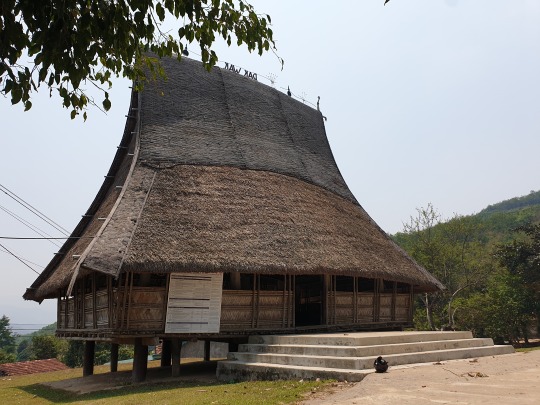
Slika 3: Tipični seoski rong
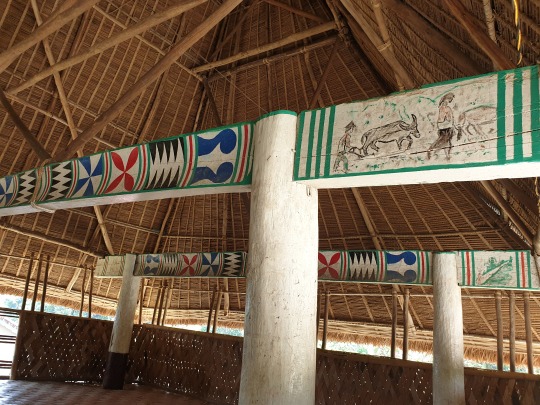
Slika 4: Unutrašnjost ronga s oslikanim gredama
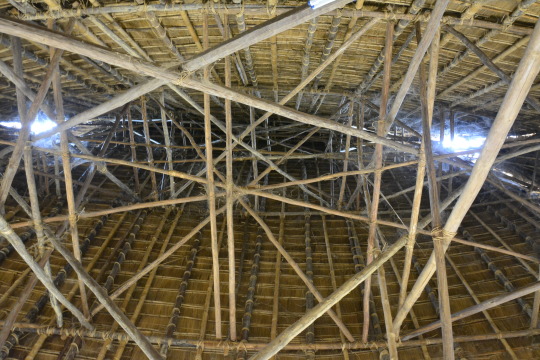
Slika 5: Krovna konstrukcija ronga - pravi mikado
Problemi manjinskih zajednica su brojni, od nedostupnosti ili niže kvalitete obrazovanja, manjka socijalne mobilnosti i prilika u životu, do sustavne političke diskriminacije zbog sudjelovanja manjiskih grupa u Vijetnamskom ratu na strani Amerikanaca itd. Jedna zanimljivost: Vijetnamci uz osobne podatke i adresu na osobnoj imaju vjeroispovjest i etničku grupu i sve navedeno se uzima u obzir kod svakodnevnih birokratskih procedura. Naravno, kao i kod ostalih bitki sa državnom birokracijom u Vijetnamu, dobro odmjereni mito znači više od etničke pripadnosti ili vjeroispovijesti. Manjine u Vijetnamu su vrlo osjetljiva tema o kojoj se i sami Vijetnamci ustručavaju govoriti, a u koju je moj uvid vrlo ograničen pa ovdje nema smisla dublje ulaziti u tu temu.

Slika 6: Klinci iz sela, improvizirane štule od bambusa
Dalje smo nastavili uzvodno uz rijeku gdje se peca i ribari, peru se djeca i veš, transportira se roba itd. Na vrhuncu smo suhe sezone, vodostaj je trenutno nizak i na mjestima ekipa mora pogurati tradicionalne drvene kajake kroz plićak. Kako se put penje uzbrdo, tu započinju rižina polja i kanjoni potočića koji teku s planine. Odradili smo klasični vijetnamski piknik uz slapiće i dogovorili s lokalcima da nas prebace kanuima nazad nizvodno za 100.000 dongova (29 kn).
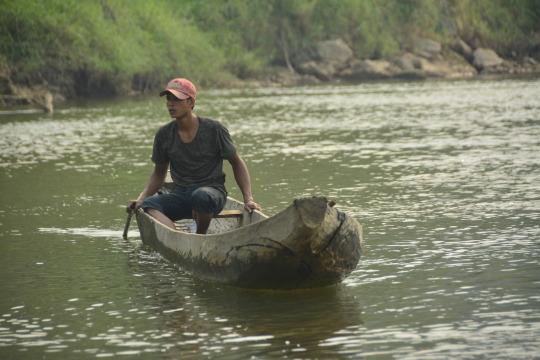
Slika 7: Opuštena vožnja brodićem
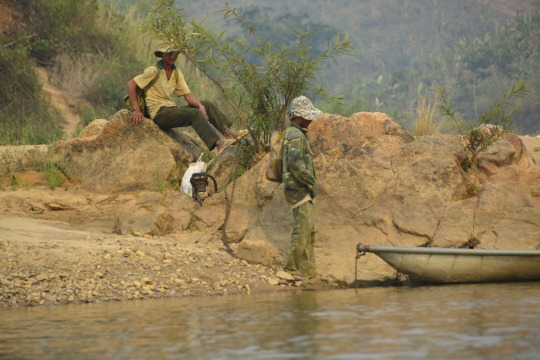
Slika 8: Nema baš hlada

Slika 9: Pranje robe

Slika 10: Čuči mališa, vidi mu se piša

Slika 11: Rižina polja
Kraj je ožujka, kišna sezona se očekuje kroz 2 mjeseca i centralna visoravan je obavijena rijetkom izmaglicom dima zbog spaljivanja jednogodišnjih usjeva kako bi se zemlja ‘resetirala’ za iduću sezonu. Ta poljoprivredna tehnika naziva se ‘slash and burn’, karakteristična je agrarnim zajednicama tropskih prostora i pripada najprimitivnijim agrošumarskim načinima gospodarenja zemljom. Sva šumska vegetacija na prostorima predodređenim za poljoprivredu i na postojećim poljima jednogodišnjih biljaka posječe se te nakon što se posušila na mjestu gdje je pala, zapali prije najplodnijeg dijela sezone, uglavnom neposredno prije dolaska monsuma. Početkom našeg kalendarskog ljeta, ovdje započinje monsumska sezona: kreću svakodnevni pljuskovi u popodnevnim satima i noću, a vegetacija buja i sve je opet zeleno. Na sasječenim i spaljenim poljima ponovno započinje ciklus i zemlja nahranjena površinskim slojem pepela bogatog nutrijentima daje temelje ubrzanom rastu zasađenih nasada.
Problem s takvom vrstom poljoprivrede je što požar osim korova i posječenih nasada jednogodišnjih biljaka istrijebi kukce i bakterije zaslužne za razgradnju odumrle vegetacije, eliminira vlagu iz zraka te narušava osjetljivo međudjelovanje biljnog i životinjskog svijeta i prirodni ciklus povratka nutrijenata u zemlju. Nakon cca 5 godina količina nutrijenata u zemlji se iscrpi i tada je potrebno nasade preseliti na novu lokaciju koja će se koristiti dok se postojeća ne regenerira. Jasno je da je ‘slash and burn’ održiv isključivo za male nomadske populacije koje uzgajaju kulture jednogodišnjih biljaka na velikim površinama zemlje. Nažalost, ruralne zajednice u tropskim područjima su sve samo ne male i bujajući problem prenapučenosti rezultira brojnim problemima takvog načina poljoprivrede: deforestacijom, gubitkom staništa i vrsta, ispuštanjem stakleničkih plinova u atmosferu, smogom i dimom u zraku, erozijom tla itd. To nas dovodi do, na ovom putovanju, meni osobno najvidljivijeg problema (uz neizbježan i sveprisutan problem plastike koja je posvuda i nepostojanja organiziranog gospodarenja otpadom): deforestacija i gubitak staništa. Vozeći se ruralnim dijelovima Vijetnama spaljeni dijelovi šuma i polja naprosto bodu u oči, noću ogromni požari pokrivaju padine planina uz cestu, a stalna izmaglica dima obavija centralne visoravni Vijetnama u proljeće. Moram priznat da su plastika i šume nagrizene ‘slash and burn’ poljoprivredom pokvarile moj dojam Vijetnama u cjelini. Naravno, ovo nisu problemi svojstveni samo Vijetnamu. Problem nepostojanja gospodarenja otpadom i okoliša pretrpanog plastičnim i drugim otpadom vjerojatno je izraženiji kod država poput npr. Indije, a vidljiv je posvuda u južnoj i jugoistočnoj Aziji. Slash and burn izaziva ogromne polemike u npr. Indoneziji gdje požari na plantažama palmi u proljeće izazivaju međunarodne incidente zbog gustog dima koji se širi u Maleziju i Singapur, u Brazilu Amazona svake godine gubi svoju površinu itd.

Slika 12: Deforestacija...

Slika 13: ...posvuda

Slika 14: Tugica
Jednog od idućih dana, na preporuku našeg domaćina, zaputio sam se u nacionalni park Chu Mom Ray, nekakvih sat vremena vožnje na zapad, na samoj tromeđi Laosa, Kambodže i Vijetnama. Park je još uvijek projekt u nastajanju, ne postoji službeni ulaz ni prilazna cesta, već samo rđava rampa i portirnica napravljena od cerade na bijelom putu kroz rižina polja. Postojeći putevi u parku nisu markirani, mnogi su tek u izradi i vidljivo je da se još uvijek radi na novima. Sam park se sastoji od dvije međusobno okomite ceste sirovog izrovanog makadama koje ga presijecaju, planine Chu Mom Ray po kojoj je i dobio ime, te džungle koja ju okružuje. Došavši do vrlo skromnog središta parka, koji je više ograđeni vrt sa betonskom podlogom za parking motora i povećom kućom za osoblje, bez ikakvih mapa, letaka, osoblja koje govori engleski ili bilo kakvog korisnog sadržaja za posjetitelja parka. Najkorisnija stvar koju ova naseobina u parku nudi je reljefna maketa parka sa označenim točkama interesa u nečijem uredu u koji sam znatiželjno zavirio i pofotkao si točke interesa. Nakon inicijalnih problema sa sporazumijevanjem, uz malu pomoć Google Translatora, djevojke su mi objasnile da ne mogu nigdje bez vodiča čiji najam košta 200.000 dongova. Tu opciju sam glatko odbio, podučen internetskim znanjem i prijašnjim iskustvima iz drugih Vijetnamskih parkova. Mjera nametnutog uzimanja vodiča za ultralagano planinarenje i trekove daleko od bilo kakve prave divljine je nešto što me jako nervira još od Tajlanda i ne želim to poticati ni na koji način. Srećom, kontakt koji mi je dao omiljeni gazda homestaya ispostavio se kao direktor Parka. Nekoliko vijetnamskih rečenica telefonom kasnije, cure su u potpunosti promijenile retoriku, mogao sam slobodno motorom nastaviti u park i hodati dalje po volji sam. Cesta je prema svim prihvaćenim standardima očajna, ali sa XR150icom je bio čisti gušt konačno se voziti po zahtjevnijem terenu i iskoristiti puni potencijal motora koji tako dugo vozimo po relativno dobrim cestama. Sama priroda je ok, ništa posebno, prošetao sam se uz poviši slap koji zbog vrhunca suhe sezone nije bio posebno atraktivan, i dalje do vrha brda. Pogled s vrha, uz činjenicu da je park potpuno prazan (nigdje na putu nisam susreo nikoga, kako zapadnjaka tako ni Vijetnamca), bio je vrhunac iskustva koje mi je ovo mjesto pružilo. Bilo je to nekoliko sati ugodne fizičke aktivnosti koja mi očajno fali na ovom podugom putovanju.

Slika 15: Maketa nacionalnog parka

Slika 16: Pogled s vrha brda
Vijetnam je ispresijecan mrežom odličnih asfaltiranih cesta na iznenađujuće izoliranim prostorima, ali kao što je moguće pronaći predivnu novu cestu koja ne postoji ni na kakvoj mapi, šanse su i da će glavni, debelo označeni put na mapi ispast neodržavani krš propadajućeg vijugavog niza rupa ili jednostavno makadam ispresijecan strojevima, materijalom i kilometrima radova. Glavne ceste na mapama često su oštećene klizištima, potopljene izgradnjom brana i sl., a nove niču bez najave na mjestima gdje bi ih najmanje očekivao. Google maps tu ne znače puno...
Putovanje na dva kotača pruža jedinstvenu slobodu koju je teško ostvariti drugim sredstvima prijevoza; uklanja ograničenja vremena i kretanja koje postavlja putovanje vlakom ili busom, a stavlja putnika u puno direktniji kontakt sa okolinom od putovanja na četiri kotača. Na motoru nema ograničenja, karoserije, lako se približiti rubu ceste, pogledati u dolinu, zaviriti preko ruba klisure, prema obzoru, vrhovima planina, osjetiti mirise sa polja, u gradu, stati, parkirati i lagano se prebaciti u neku drugu aktivnost, ili neobavezno razgledati i nastaviti dalje... Ipak, zahtijeva određenu dozu avanturističkog duha, aktivno sudjelovanje, fokus na vožnju, strpljenje i fleksibilnost oko mogućih problema na putu, vremenskih (ne)prilika i vremena dolaska. Avantura je za mene smisao putovanja po egzotičnim mjestima poput jugoistočne Azije i mislim da su spomenute vrline potrebne svakom tko se upusti u nezavisno putovanje ovim krajevima, bez obzira na sredstvo prijevoza.

Slika 17: Na motoru
Odrastajući u Puli, gdje među klincima postoji skoro pa rednečka strast prema vožnji i prčkanju ispod haube raspalih peglica, stojadina, thomosovih APN-a, skutera, ugrađivanju čipova, Marmitta, Akrapovića i ostalih pizdarija na motore, razvio sam odbojnost prema tim trendovima. Jednostavnije rečeno, moj interes za išta vezano uz mehaniku, vožnju ili koncept motora kao dijela lifestylea bio je ravan nuli. Štoviše, bio sam aktivni hejter cijele te priče. Sve se promijenilo prije nekakvih pet godina kad me sila prilika natjerala na putovanje motorom po Palawanu, otoku na Filipinima. Bilo je to vrijeme dok sam odrađivao semestar na sveučilištu u Tajvanu. U društvu nekolicine kolega s kojima sam dijelio kat u domu krenuo sam dvotjedni izlet na Filipine tijekom famoznog ‘spring breaka’ - pandana našim uskršnjim praznicima na faksu. Momci su bili iskusni vozači i odlučili su rentati motore kao najbolji način da obiđemo otok. Prije toga imao sam ograničeno iskustvo vožnje skutera, isključivo automatika, što po kvartu kad sam bio klinac, što u Tajvanu gdje je to bio glavni način prijevoza studenata. Na motor s brzinama prije toga nisam ni pomišljao, a kamoli znao kako se vozi. Ne želeći ispasti ubojica spike i ustopirati akciju, ubrzo sam popustio nagovorima i pristao unajmiti motor. Nakon ubrzanog jednodnevnog tečaja kojeg su mi momci dali i preznojavanja sa kvačilom na motoru od 250 kubika koji mi se tada činio kao neukrotiva zvijer, sutradan sam već vozio stotinjak kilometara uzduž otoka. Srećom, platio sam danak svojoj mladenačkoj ludosti samo u obliku nekoliko sitnijih ožiljaka i poderanih majica. Desetak dana vožnje po makadamu na Palawanu i 3 pada s motora kasnije, bio sam navučen na ideju putovanja na 2 kotača. Čvrsto sam odlučio iskoristiti sve prednosti motora i po povratku kući položiti A kategoriju i ovladati vještinom upravljanja motorom. Pet godina kasnije, internacionalna vozačka je u džepu, skuter parkiran u Zagrebu, a mi vozimo Ho Chi Minh roadom uz granicu Vijetnama i Laosa na sjever...

Slika 18: Vožnja kroz rižina polja
Koliko god mi draga bila činjenica da je Goga odlučno zakoračila daleko izvan svoje comfort zone i pristala u Vijetnamu putovati motorom, njezin paničan strah od moguće nasilne smrti na motoru ograničio nas je na izrazito duge i spore, cijelodnevne dionice vožnje, dane provedene na suncu i u prašini vozeći prosječnom brzinom od 40-ak km/h. Motori koje smo iznajmili kombinacija su cestovnog i malog off-road motora, nisu prejaki niti preteški za kontrolirati, a opet imaju dovoljno kvalitetne suspenzije za nošenje i sa najgorim blatnim i kamenim cestama. Nije da ona ne zna ili ne može voziti bolje, u ovih 3+ tisuće kilometara njezina vještina vožnje eksponencijalno je porasla, međutim psihičke kočnice su i dalje jake. Meni se taj način vožnje pokazao kao izuzetno fizički i psihički naporan. Teško mi je zadržati fokus na prometu i vožnji kroz dugo razdoblje pri jednoličnoj sporoj vožnji, a uspravan položaj sjedenja na motoru bez dinamičnih pokreta tijela i naginjanja ubija mi leđa. O vožnji na otvorenoj cesti dok je tropsko sunce u zenitu i bolovima u guzici nakon šestosatne vožnje bolje da ni ne govorim. To me ostavilo da žudim za malo aktivnijom vožnjom koju su mi naše Honde XR150 mogle pružiti na ovim cestama. Kao utjeha ostali su mi dnevni izleti na koje sam se ponekad znao uputiti sam ili bi išli samo jednim motorom.
Takva je bila i vožnja cestom kroz rezervat prirode istočno od ‘dugih planina’ - planinskog lanca Truong Son Dong koji odvaja centralne visoravni od ostatka gorja na istoku. U neposrednoj okolici Kon Tuma zemlja je ravna. Plantaže kaučuka ovdje su nasad izbora i pokrivaju zemlju uz prilaze gradu i okolnje obronke. Čim se pređe prvi red brežuljaka započinje prostor vrlo dojmljivog reljefa, potočići, rižina polja i manjinska sela. S druge strane planina nalazi se osvježavajuće netaknuta kišna šuma, bez sela, polja ili ožiljaka spaljene zemlje igdje uz cestu satima. U jednom trenutku, na samom rubu parka, na cesti mi se ukazao bizaran prizor. Usred ničega, dvije trake ceste pretvaraju se u kilometar ravne cesturine sa 6 traka nakon čega opet postaju skromni dvotračni cestuljak kroz šumu. Palo mi je na pamet da je to Vijetnamski pandan našem potezu autoceste kod Grobnika koji je za vrijeme Jugoslavije imao dvojnu funkciju: koristio se i kao cesta, i kao avio pista u slučaju nužde, ali nisam uspio pronaći službenu potvrdu svoje teorije. Cesta se nakon toga naglo spušta u dolinu i skreće zapadno kroz planinski lanac. Sunce je spektakularno zašlo iza dugih planina na zapadu, a ja sam zaokružio turu noćnom vožnjom natrag kroz planine južno od Kon Tuma.

Slika 19: Pitoreskna cesta zavija kroz krajolik

Slika 20: Plantaža kaučuka

Slika 21: Riža posvuda

Slika 22: Čisti zen

Slika 23: Cesta ili avionska pista?

Slika 24: Idila pred suton
Po povratku u homestay bilo mi je jasno da je Goga puno bolje. Večerašnja postava gostiju je bila za stolom, hrana servirana i svi su već veselo ćakulali o doživljajima i planovima za dalje. Došlo je vrijeme da se zorom oprostimo sa domaćinima, zajašimo svoje ždrijepce i odjašemo na divlji sjever. Falit će mi njihove raskošne gozbe na kojima se količina hrane ne smanjuje koliko god se trudio dovršiti obrok. Tu bih ovu tiradu, koju sam si dopustio dobivši glas na blogu, priveo kraju.
Luka
2 notes
·
View notes
Photo

Raketni sistem Pancir koji je zaglavio i napušten u blatnjavom polju izgubio je nekoliko guma kada su ukrajinske snage pokušale da ga odvuku, a Trent Teletenko - bivši državni službenik Ministarstva odbrane - napisao je na Tviteru da se čini da Rusija nije uspela da održi gume na svojim vozilima, ostavljajući ih lomljivima.Prema njegovoj analizi, to znači da će snižavanje pritiska u gumama - što se obično radi kako bi se mogli voziti van puta - dovesti do njihovog raspadanja, što znači da će kamioni i artiljerijski sistemi biti ograničeni na autoputeve ili u suprotnom rizikuju da zaglave u blato.Druge slike prikazuju oklopna vozila zaglavljena i napuštena nakon što su ruske snage pokušale da polože iseljena stabla ispod točkova kako bi ih sprečila da se uvuku u blato.U svakom slučaju, što duže ruski konvoj ostaje zaglavljen, to postaje ranjiviji na ukrajinski kontranapad i što ljudi Kijeva duže mogu da žive bez rizika od granatiranja.
0 notes
Text
"Sve te to ljuti, ali znajući, da ne možeš biti ljuta na mene, dozvolim sebi tu vrstu slobode. Ne znam da li lepo pevaš, ali volim, da te slušam dok to radiš. Ne želim, da budem napadan, ali opet, ne mogu, da pustim, da milionito "volim te" ostane duže od sekunde onda kada mi padne na pamet, da ti to saopštim. Ne znam odakle se pojavljuju nove pesme, kada imam osećaj, da sam ih sve odslušao, ali se tako zaglave i mogu se ponavljati po ceo dan."
Spasi me od sebe, Nikola Đokić
#djokic_je#srbija#croatia#hrvatska#bosna i hercegovina#crna gora#makedonija#balkan citati#citati#zivotni citati#citati o ljudima#ljubavni citati#balkanski citati#sarajevo#balkan#bosna#citati o ljubavi#najljepsi citati#citati o zivotu#balkan tekst#balkanski tekstovi#ljubavni tekstovi#tekstovi#tekst#tekst iz knjige#nikola djokic#spasi me od sebe#volim te#pesma#proza
1 note
·
View note
Text
Arrival on Dugi otok: The monastery and the locals in Zaglav

Zadar’s archipelago. The trip started in Zadar and ended up in Zaglav on the first day.
I took the bus **from Zagreb to Zadar **at 6am and planned to get on the first boat that goes for **Zaglav **afterwards. While almost missing the bus in the morning I managed to get there in time and bought the ticket for my catamaran. The ticket for the non-islanders was about 20 -25 HRK (around 3 Euros) for one direction. Soon enough I was aboard the catamaran whose trip to Zaglav took around an hour and 15 minutes. During the trip I had the pleasure to talk to one of the locals from Sali who shared some tips on the DOs and DON'Ts on the island.
On it’s way to Zaglav we went beneath the bridge that connects the islands Ugljan and Pašman passing by the town of **Kali **(another place on the list to visit). Then you find yourself surrounded with multiple islands I couldn’t remember the names yet the last one to the west had numerous hills, so long you couldn’t see its end. Of course it was Dugi otok (the Long island). I’ve never been so far to the west in this area and the inner Indiana Jones for exploring and adventures was waking up.

This was my printed map of the island. I removed the names of the wanted locals for the interview and where to find them in each place due to privacy.
Soon we reached Sali and headed then few minutes to the north to Zaglav. I took all the stuff I had and I had several bags and a luggage. Just before we reached Zaglav I had two phone calls from my local saviours. One was from friar Izak, the monk from the monastery, who was waiting for me and my stuff with his squad in his car. The other one was Goran, the guy responsible for delivering the bakery products across the island throughout the year in his van. He was the one who helped me with the vehicles by lending me his old car to use for four days. Just when I stepped on the island he was there at the gas station tanking it up fully. Yes, full till the end. I gave friar Izak and his fellas my stuff and met with Goran and his family to take me up to the monastery.
Here it was where I earned the name „The Baker“ in the next couple of days. It started with his wife asking me „So, are you a baker?“ and later on several locals who’d see me coming by car (as Goran does) would frequently ask me „Are you a baker?“. In the end I gave up and said „Yes, I am a baker“. The second name that followed me was “The Journalist guy”.
We went uphills. Now here is a thing with the most places on Dugi otok. The core of these villages is mostly on the hill, not next to the sea. People went down to the coast much later. The monastery was at the end of the road on the hill. Also, the roads are only for one vehicle at the time which was interesting as you had to be careful if someone from the opposite direction was coming from behind the corner and then one of you two would have to somehow the way to step aside. That was done either by going backwards or finding a quick spot to move aside. Not to say that many of these roads or streets were pretty narrow and at some points you were surrounded with the stone fence wall. All of this makes it easy to damage your car. In the beginning I was more careful with it but then grew confidence because simply the things like that are just normal there and you gotta accept it. Again, you can’t do this in Zagreb without bad consequences.
**The monastery of St Michael **
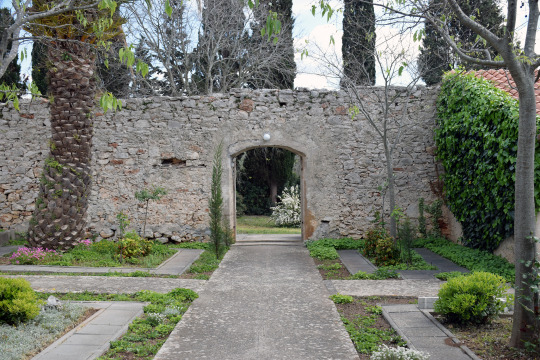
The entrance as seen from the center of the yard
Voila, there we are at the monastery. Somehow typical Dalmatian look or actually Mediterranean. Bell tower, local graveyard and the monastery with its yard and garden just at the end of the street. Soon arrived friar Izak and the other dudes. Passed through the gates in the middle of the wall and entered the yard. It was guarded by two cats.
The Franciscan monastery and the church of St Michael were built back in the mid-15th century by the Franciscan order of the Glagolitic monks. Glagolitic is one of the old Slavic scripts, somewhat similar to Cyrillic, that was preserved in Croatia mostly on the islands and some northern areas within the religious context and local or folk language. The monastery today is of course an expanded version of the original one.

The monastery and the church as seen from the bell tower
When seeing all these stuff inside the yard and this whole idea of being in the monastery I quickly returned in my head to Robin Hood games where you had to sneak and climb around monastery’s walls and hallways. It would have been awesome if I had visited it with my friends back in the childhood though even now it could serve as a cool film location. But the best impression of the monastery and its surroundings is surely early in the morning when it’s fresh and enjoyable to be outside, the shadows are soft, relatively quiet, you can hear the animals and prepare for the day with pleasure. I tried doing some exercise in the morning but failed.

The look from the entrance into the yard. My window is on the second floor in the middle.
When you say „a monastery“ you might think of the medieval buildings where they still use the candles but man, I got 5-stars room with my own bathroom. So there were now three of us residing in the building and each of us had our own room upstairs. Once you enter the monastery you are in the hallway where to your right is a small library. Straightforward you got one SOS restroom and then the stairs to our rooms. The hallway there was filled with some large paintings of religious content and Glagolitic engravings. Back downstairs, to the left, one enters the „living room“ where they can watch TV and turn on the oven when necessary. Few steps behind and you enter a modest kitchen with plenty of food. Oh yes, they said I just pick up whatever I want and they had lots of stuff. Even better, behind the kitchen in the basement they had a pantry. It felt like Goku being on King Kai’s small planet with whatever you want.

Some hallway paintings of…well… someone
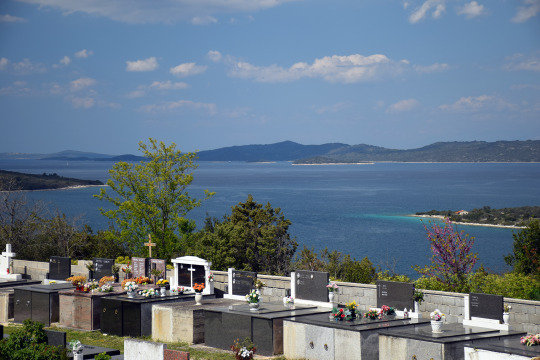
The look from the windows on the other side towards the north. What you probably see are the islands of Krkata (the closest one), then Iž and maybe far away Ugljan or Sestrunj..or something else, who knows, so many islands…
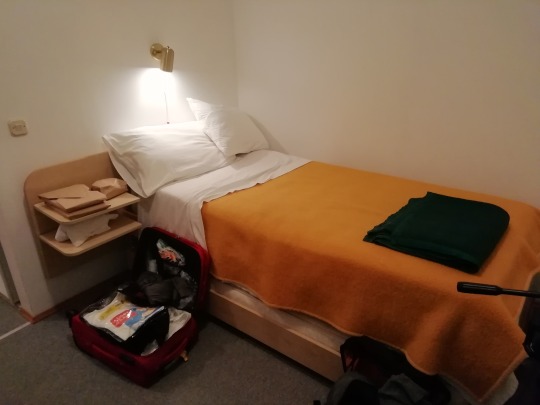
One part of my room…the rest is in the mess but there’s a table behind me, the window and to the left is the small hallway with the wardrobe and separated bathroom
The view from my room taken in the evening
Soon enough I was welcomed with the lunch. They have a lady who cooks and cleans for them every day and this was also covered so that I don’t have to spend money aside. As you can see this all was really way more than I expected.

Friar Izak taking care of the stuff in the kitchen
This was probably the only lunch I had with them as I spent every next day somewhere else waddling around. We made some rules about breakfast around 7am and had dinner together in the evening. Even though they usually go to sleep by 10pm we used to talk about different topics until midnight.
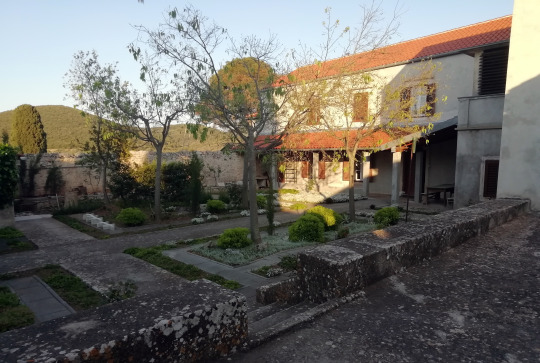
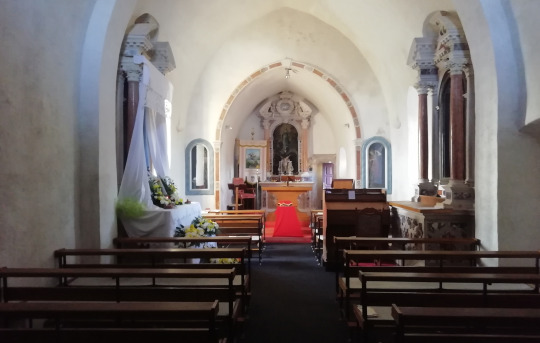
The first photo is of the monastery’s yard. The second one from the Church’s interior
And what about friar Izak? He definitely is a guy with lots of energy and ideas. Born in Zaglav in 1936 but spent most of the time away from the island he is a a big church musician, conductor and a researcher of the Glagolitic heritage. He is also one of the founders of the mixed choir “Bašćina” (Heritage) and several years ago revived the real Renaissance Zaglav liturgical singing. He is fun to talk to and throws the jokes all the time. More about the conversations and his stories in the upcoming posts.
Zaglav: An afternoon in the bay of Triluke (Three ports). Meet the first locals.
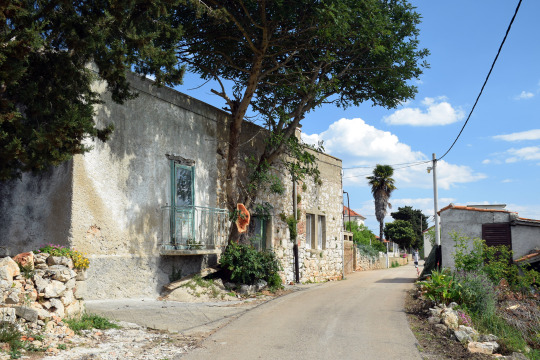
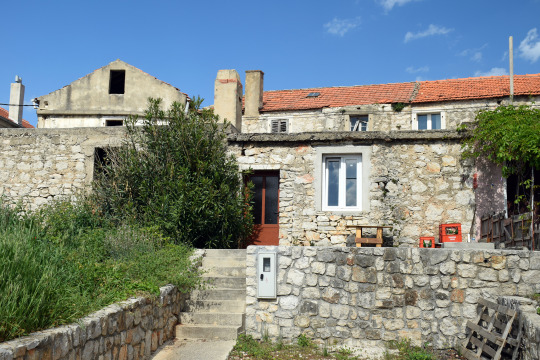
After lunch I decided to go down to the village on the coast. Grabbing my camera and other stuff I took the path that goes to the bay. I had it in plan to meet with Zvonko – the young gas station owner whom I reached few days earlier. He knew I’d come and so he helped me to find the potential candidates for the interview. But what about Zaglav?

The road down to the bay of Triluke
It’s a village in the southern part of Dugi otok between Sali and Žman. The records say it was inhabited in 15th century and many of the locals are the descendants of people who flew before the Ottomans. The population of Zaglav is around 174 people though there used to be 300-500 people just few decades ago. I’d say today it’s even less than 170 but we will find out more in 2-3 years. People there mostly live from tourism, sailing and fishing with some small agriculture part. Some work in Sali or move to Zadar or other places on the mainland. Zaglav has a relatively good boat connection with other places and the mainland. Here used to be a ferry port before they moved it to Brbinj. I didn’t go around the whole village on the bay but down there you can find a few restaurants and the gas station also serves as a small store. **This gas station for the cars and the boats is the only one on the island. **

So while walking through this street downstairs I met Zvonko and his dog at the gas station and soon was introduced to the other local dudes who gathered nearby and enjoyed some drink. There I met my future companion and help for the upcoming days - Mirel. After receiving a welcoming drink and introducing myself Zvonko took me to our first star - his father who was repairing the fishermen’s net. Here comes the summary of the interview I had.
Mr Špralja the Sailor

As I approached hime while repairing the net he started explaining me the type of the net he uses and what kind of fish it can catch. He learned the skill from his father and grandfather. Being in pension for many years and not being able to move a lot his main hobbies are repairing and maintaining the nets plus doing some work with agriculture. Right now he had problems with the holes made by the dolphins but as he said - it’s gonna take him around a week to finishing repairing this net around 100 meters long.
His family came from Bakar to Zaglav and** Kornat island** which is the story many other locals shared.
He had spent over 30 years sailing around the world going twice around the equator and visiting all the continents and ports except for Australia and New Zealand. He told me the only experience he remembers most that scared him was during their trip aboard the Jordan Nikolov ship on the Atlantic ocean during the stormy weather where he had to go down inside the ship and make sure to have the gas ventilation closed. As he added “There are no good things on the sea, only the bad ones.”. Also, he believes the young sailors nowadays have it much easier as they don’t have to spend a whole year on the boat and vehicles (technology) is much faster and precise.
Speaking of the food and how it used to be back then he started with the meals they got on the ship. As there used to be 30-50 crew members they had two cooks and one assistant adding that the food was “solid”. On the island, back in his youth days, the main food was fish. The meat as we eat it today was not available and couldn’t be bought easily. You would use what you had of your livestock which included lamb, goats and mutton. In winter they used to fish for the smaller fish, 30-50 of them weighing around a kilogram. In spring there was more of the bluefish such as mackerel or chub. Cuttlefish or an octopus were also options. Dried octopus, he added. They didn’t have much of the potato and people mostly ate collard greens. Berries and beans were also popular. The problem was that the fields on the island were not as rich and potent for the agricultures as it is on the mainland and there has never been much of the freshwater. Those families who had some livestock such as goats or sheep would make milk and cheese. For breakfast you had milk and cheese, fish or some other meat for lunch and for dinner different types of greens.

Repairing the net where two bigger holes were made by the dolphins
What about games and how they used to play as children? The hide and seek obviously never gets out of fashion, no matter the generation. Among other games football was popular, played in the “Old village” upon the hill. However, there weren’t balls like today so they used the the ones made from rags. During the carnival and masquerade there is a custom of setting a fire etc.
And schools? He told me there was around 10 of them in the generation that went to school in Zaglav and Sali that had up to 7-8 grades. Those who wanted to learn a foreign language would have to go to Sali. There he learned a bit of German and his knowledge of English came through navigation around the world. In the end, he forgot almost everything since he returned to the island.
Finally, he believe young people will have an easier life as there are much more opportunities than in his days. Tourism is the number one industry. The problem with the agriculture he sees is that it’s not enough today to earn for a living and many fields were divided into plenty of smaller parcels and those who own them stopped carrying for the land. He concluded again that only with the tourism he can see the youth prosper.
Afterwards we visited three more people whom I asked similar questions. However, I will share the story of the last ones – an old couple living alone in their home. The story of Marjan and Vera Špralja is one of the sad ones you are going to hear.
Life story of Marjan and Vera Špralja

I met them upstairs on their terrace enjoying the snacks and soft sunlight. Though at first a bit reserved and silent soon they warmed and opened up. Quiet simple and modest people who had experienced a lot. Both over 80 years old.
We started with the family background. They came to Zaglav from Kornat island though their ancestors came to these areas from the mainland around Bakar town. Marjan was the eight out of ten siblings and probably the only one who stayed on the island whereas the other went to different places and countries looking for the better opportunities. One of his brothers is living in Australia. They stayed here on the island as the simple shepherds and fishermen. They spent 20-30 years living in the Old Zaglav upon the hill before moving to the bay. They also spent most of their lives on Kornat island. Further on, they explained me the name of the bay – Triluke (Three ports) and the division between the village „up there“ and „down here“. Up in the Old Zaglav (S_taro selo_) there are mostly seniors living, not many of them…while the bay is filled with younger members of the community, families with children.
Speaking of the past they reminded me that once there lived around 400 people in Zaglav while today there might be not more than 50-60, he guessed. The school that used to be open is now closed. This also comes from the fact that families in the past were much bigger with 5-8 siblings. The same case was with my grandmother.
I wondered how the two of them had met. They happen to meet each other back in the elementary school. They said they finished only 3-4 grades and have the essentials skills for living – writing, reading, driving the car and the boat…and some knowledge about the agriculture. There were no teachers, they said. The one teacher used to come twice per week to teach the locals.
We moved to the stories of being on the sea. Marjan is an experienced fisherman and we would have needed an extra day to listen to all of it. The biggest enemy he’s always encountered was the stormy weather at the sea and the wind. One time, during such occasion, he was forced to jump from the boat into the sea in order to push it to the shore otherwise the boat would have been lost.
However, the biggest tragedy they have encountered is with their children. Their son died at the age of 19 losing battle to illness and their daughter (50) is fighting the similar battle laying immobile in the hospital. “Misery and sorrow, that’s our story.” Vera told me.
She moved on saying “We had the sheep on Kornat island, we were fishing, we had a vineyard…and I had been working at Mardešić Fish Factory in Sali for 26 years. And ill children. Nowadays people complain they have no time for anything. They have one child and still busy all the time.” - “Yeah, they waste their whole day trying to put on the make-up”, added Marjan. “We also got up earlier than people today.”
The house they live in was built by Marjan himself. They sold one house to a cousin who took care of them since they won’t have any heirs - otherwise they would keep it for their children. Vera is today suffering from several pains and the similar goes with Marjan. Apart from the cousin who visits them sometimes they have no one else on the island who can help them. The hard life and problems took toll on their health.
We came back to childhood they also described as a misery and famine. Marjan explained there was no such luxury as today to have smoked ham and cheese on your table along with other food we throw away recklessly…but dried figs mostly. Vera carried on pointing me the oranges, olives and lemons they have in their garden. They are happy as they get the fruits from those trees three times in a year.
We ended up our conversation with them asking me about my background and how come I ended up on Dugi otok. They thanked me for visiting them and I was thankful them having shared their time with me.
We are done with the interviews in Zaglav. I came back to the gas station where I met Mirel leaving in his car. He gave me a book about Dugi otok and NP Kornati. As I found out Zvonko had told him to watch over me and help me getting around. Sounds like Sam and Frodo thing. We made a deal to visit Sali in the evening and go for some pizza.
I returned back to the monastery and spent some time talking to the monk-dudes.
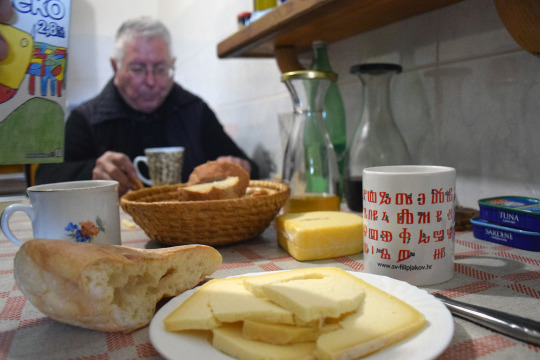
Dinner with cheese, bread and wine with my fellas from da monastery
More about the upoming evening in Sali and visiting the cliffs of Telašćica near Fort Grpašćak in the next post!
Grgo
#dugi otok#dalmacija#dalmatia#zaglav#samostan na zaglavu#samostan sv mihovila#monastery dalmatia#long island croatia#interview#the locals#documentary#photography#video#tradition#customs
0 notes